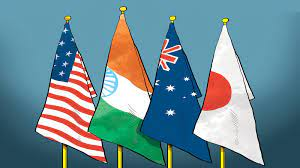CURRENT AFFAIRS
Get the most updated and recent current affair content on Padhaikaro.com
QUAD
- Vaid's ICS, Lucknow
- 10, Feb 2022

G.S. II
Topics Covered: Important International institutions, agencies and fora, their structure, mandate.
Context:
With China and Russia coming closer, the US has planned to “enhance cooperation, engagement, strategic and economic ties” with its Quad partners.
Focus areas:
- To further bolster ties between their countries at all levels of government while finding creative and holistic ways to manage national security risks.
- To facilitate better coordination on international engagement between national and subnational officials throughout the four participating countries.
Need for:
As competition continues between China and members of the Quad, it will be critical to find ways to creatively engage in ways that mitigate risk.
What is Quad grouping?
The quadrilateral security dialogue includes Japan, India, United States and Australia.
- All four nations find a common ground of being the democratic nations and common interests of unhindered maritime trade and security.
Genesis:
The grouping traces its genesis to 2004 when the four countries came together to coordinate relief operations in the aftermath of the tsunami.
- It then met for the first time in 2007 on the sidelines of the Association of SouthEast Asian Nations (ASEAN).
- The intention was to enhance maritime cooperation between the four nations.
Significance of the grouping:
- Quad is an opportunity for like-minded countries to share notes and collaborate on projects of mutual interest.
- Members share a vision of an open and free Indo-Pacific. Each is involved in development and economic projects as well as in promoting maritime domain awareness and maritime security.
- It is one of the many avenues for interaction among India, Australia, Japan and the US and should not be seen in an exclusive context.
What are China’s views on the Quad?
- There is a general understanding that the Quad would not take on a military dimension against any country. The strategic community in China, nevertheless, had branded it an emerging “Asian NATO”.
- Notably, Japanese PM Shinzo Abe’s “Confluence of Two Seas” address to the Indian Parliament gave a fresh impetus to the Quad concept. This recognised the economic rise of India.
Facts for Prelims
Wayanad Wildlife Sanctuary
- The sanctuary is a component of the Nilgiri Biosphere Reserve(5,520 sq km) and is a vital component of the Elephant Reserve No. 7 of South India.
- It is the only sanctuary of Kerala where sightings of four-horned antelopeshave been reported.
- Presence of Egyptian vulture, Himalayan griffon, and Cinereous vulturesare also reported in the sanctuary and the two species of vultures, red-headed and white-backed vultures, once common in Kerala, are now restricted to the Wayanad plateau.
- The Nagarhole-Bandipur-Mudumalai-Wayanad forest complexis also one of the most important tiger habitats in the country.
- The forests of the wildlife division form the major catchments for the tributaries of the Kabini river system.
Context:
Seasonal migration of wild animals has begun from the adjacent wildlife sanctuaries in Karnataka and Tamil Nadu to the Wayanad Wildlife Sanctuary (WWS) in Kerala.
Sowa Rigpa
- It is a traditional system of medicine practised in the Himalayan belt of India.
- It originated in Tibet and popularly practiced in countries namely, India, Nepal, Bhutan, Mongolia, and Russia.
- The majority of theory and practice of Sowa-Rigpa is similar to “Ayurveda”.
- Yuthog Yonten Gonpo from Tibet is believed to be the father of Sowa Rigpa.
The basic theory of Sowa-Rigpa may be adumbrated in terms of the following five points:
- The body in disease as the locus of treatment.
- Antidote, i.e., the treatment.
- The method of treatment through antidote.
- Medicine that cures the disease.
- Materia Medica, Pharmacy & Pharmacology.